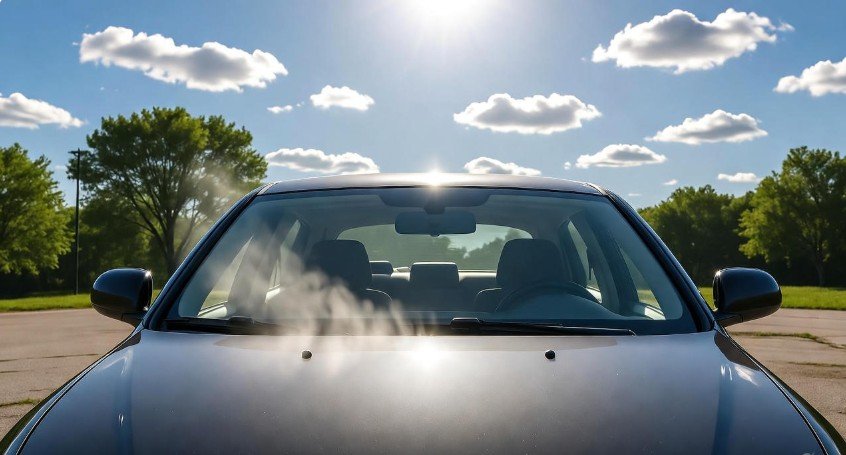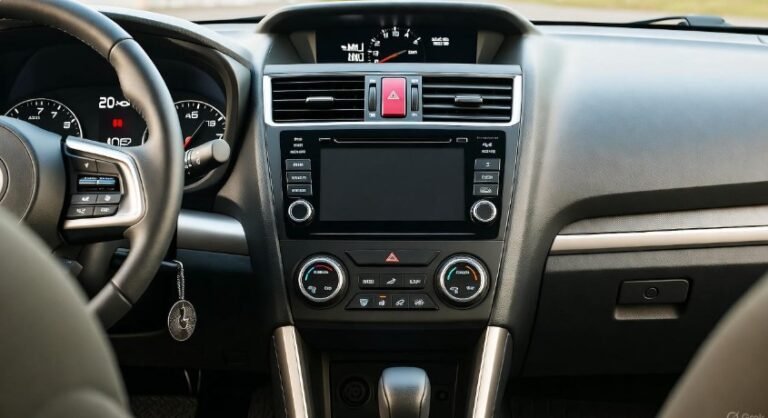How Hot Can a Car Get in the Sun? 7 Surprising Facts Revealed!

Have you ever opened your car door on a summer afternoon and felt like stepping into an oven? That blast of scorching air isn’t just uncomfortable—it can be downright dangerous. Many drivers underestimate just how hot a car can get in the sun, even when parked for only a few minutes.
On a typical sunny day, the air outside might feel warm, but inside a parked car, it becomes a different world altogether. The metal body and glass windows trap sunlight, turning the car into a mini greenhouse. Within minutes, the temperature can soar to alarming levels. I once left my car at noon to grab a coffee, and by the time I returned 15 minutes later, my steering wheel felt like a frying pan!
This article will uncover 7 surprising facts about how heat builds up inside cars, why it’s so dangerous, and what you can do to stay safe. Let’s explore how a simple act—parking under the sun—can quickly turn risky.
1. The Greenhouse Effect: The Real Culprit Behind Hot Cars
The main reason cars get so unbearably hot is something scientists call the greenhouse effect. Imagine your car as a giant solar trap. When sunlight hits the windows, the glass lets in visible light but blocks much of the infrared radiation from escaping. The result? The heat gets stuck inside, and your car becomes a heat chamber.
Even if you roll down your windows slightly, it barely helps. The air inside continues to heat up faster than it can escape. Studies show that within just 10 minutes, the temperature inside a car can climb 20°F (11°C) higher than the outside. Leave it parked for an hour, and it can exceed 40°F (22°C) above the outdoor temperature.
Think about this: if it’s 85°F (29°C) outside, your car’s interior could hit 125°F (52°C) or more in under an hour. That’s hot enough to melt crayons, damage electronics, or cause burns when you touch metal surfaces.
Here’s a quick look at how fast temperatures rise inside a parked vehicle:
| Time Parked in Sunlight | Outside Temperature (°F) | Inside Car Temperature (°F) |
|---|---|---|
| 10 minutes | 85 | 104 |
| 30 minutes | 85 | 119 |
| 60 minutes | 85 | 130 |
So, the next time you think “it’s only a few minutes,” remember—your car interior heats up faster than you think.
2. Metal, Glass, and Color: How Your Car’s Design Traps Heat
The materials and color of your car play a huge role in determining how hot a car can get in the sun. Cars aren’t all equal when it comes to absorbing and retaining heat.
-
Dark-colored cars absorb more sunlight than lighter ones. A black vehicle can reach up to 140°F (60°C) inside, while a white or silver one might stay around 120°F (49°C).
-
Glass windows amplify the greenhouse effect. They allow light in but trap heat waves inside.
-
Metal roofs and dashboards store heat and radiate it back into the cabin, creating a baking effect.
I once owned a black sedan, and during summer, the seats felt like molten lava after just 20 minutes under the sun. I eventually switched to a light silver SUV, and even though it still got hot, it was noticeably cooler.
Pro tip: Use reflective sunshades or ceramic window tints. These help block UV rays and keep your car’s temperature under control.
3. How Fast Can a Car Heat Up? The Startling Speed of Danger
If you think it takes hours for a car to overheat inside, think again. One of the most surprising facts about how hot a car can get in the sun is how quickly it happens.
In a test conducted by the National Highway Traffic Safety Administration (NHTSA), even with windows slightly open, the interior temperature rose by 19°F (10°C) in 10 minutes. Within 30 minutes, it climbed nearly 34°F (19°C). That means on a 90°F (32°C) day, your car could reach a deadly 124°F (51°C) before you finish your lunch.
This rapid rise in temperature is especially dangerous for children and pets, whose bodies heat up faster than adults. Heatstroke can begin when body temperature hits 104°F (40°C), and it can be fatal at 107°F (41.6°C).
A chilling truth: cracking the windows doesn’t make much difference. It might help a bit with air circulation, but not enough to prevent the deadly heat buildup.
So, next time you park your car under the sun—even if “just for five minutes”—remember, it doesn’t take long for danger to develop inside.
4. The Hidden Dangers: What Extreme Heat Does to the Body
Many people underestimate how harmful high car temperatures can be to the human body. The risks go far beyond feeling sweaty or dizzy. Prolonged exposure to intense heat inside a car can cause heat exhaustion, dehydration, and even heatstroke.
When your body overheats, it tries to cool itself through sweating. But in a confined, humid car environment, sweating becomes less effective. As your core temperature rises, your heart works overtime, leading to dizziness, confusion, or even fainting.
If the temperature continues to rise, you could experience:
-
Nausea and rapid heartbeat
-
Headaches and fatigue
-
Seizures or loss of consciousness
-
Organ failure or death in severe cases
Even healthy adults aren’t immune. And for children or elderly passengers, the risk is far greater. Their bodies regulate temperature less efficiently, meaning they can succumb to heatstroke much faster.
Think of your car like an oven—once the heat builds, it doesn’t discriminate. The longer you stay, the more dangerous it becomes.
5. The Deadly Consequences for Pets Left Behind
Perhaps the most heartbreaking consequence of how hot a car can get in the sun involves our furry friends. Every year, hundreds of pets suffer heat-related deaths because they were left in parked cars.
Dogs, for instance, regulate body temperature primarily through panting, not sweating. But in a sealed car where the temperature climbs past 110°F (43°C) in minutes, panting becomes useless. Within 10 minutes, a dog can experience heatstroke, leading to organ failure or death.
Here’s what most pet owners don’t realize:
-
Rolling the window down slightly doesn’t provide enough ventilation.
-
Parking in the shade only delays the heat buildup—it doesn’t prevent it.
-
Even on a 70°F (21°C) day, a car’s interior can exceed 100°F (38°C) within 20 minutes.
If you ever see a pet trapped in a hot car, act fast. Try to locate the owner, contact animal control, or in emergencies, call the police. Many regions have “Good Samaritan” laws that protect those who break windows to save an animal’s life.
Our pets trust us completely—it’s our duty to protect them from silent killers like trapped heat.
6. Smart Prevention: Simple Ways to Keep Your Car Cooler
Now that you understand how hot a car can get in the sun, it’s time to talk about prevention. While you can’t stop the sun from shining, you can take a few smart steps to reduce the heat inside your vehicle.
Here are some simple yet effective ways to keep your car cooler:
-
Park in the shade: Whenever possible, find a shaded area or use a covered parking lot. Even partial shade can make a big difference.
-
Use sunshades: A reflective sunshade on your windshield can reduce cabin temperature by up to 15°F (8°C).
-
Tint your windows: High-quality ceramic or carbon tint can block up to 99% of UV rays, keeping interiors cooler.
-
Crack windows wisely: While it doesn’t stop heat buildup, leaving a small gap helps reduce pressure and allows minimal airflow.
-
Cover your steering wheel and seats: Using towels or seat covers can prevent burns when you re-enter the car.
-
Ventilate before entering: Open all doors for a few minutes before sitting inside to release trapped heat.
These may sound like small habits, but together they can make a huge difference in safety and comfort—especially during the blazing summer months.
7. The Shocking Reality: Real-Life Stories That Hit Home
Sometimes, numbers and statistics don’t convey the emotional weight of this issue. Real stories do. Every summer, news headlines remind us of the tragic consequences of leaving people or pets in parked cars.
In one heartbreaking case, a mother in Texas left her toddler in the car “just for ten minutes” while running an errand. The outside temperature was 92°F, but inside the car, it soared past 130°F. By the time she returned, it was too late.
There are also countless pet-related incidents that go unreported. Many pet owners believe that leaving the air conditioner on or windows open slightly will keep their pets safe—but that’s a dangerous assumption.
Each of these stories serves as a painful reminder: no errand, no convenience, is worth a life.
8. Why Your Car Can Be Hotter Than the Outside Temperature
Many people assume that a car’s interior will only be as hot as the air outside. However, due to the greenhouse effect, your vehicle can become significantly hotter than the ambient temperature. The metal body absorbs sunlight and radiates heat, while the glass windows trap it inside.
A surprising fact: a car parked in the sun can reach 140°F (60°C) or more even on a moderately warm day. That’s hotter than some ovens! This explains why children and pets can suffer heatstroke so quickly—they don’t have the capacity to cool down fast enough, and their bodies heat up much faster than an adult’s.
Even leaving the windows slightly open only slows the process minimally. The sun’s energy is powerful, and once it’s trapped inside, there’s no escape unless you actively ventilate the car. Understanding this fact is critical to avoiding preventable tragedies.
9. Heat’s Hidden Effects on Car Interiors and Electronics
It’s not just living beings that suffer in extreme car heat. The intense temperatures inside vehicles can damage your car’s interior and electronics over time. Leather seats can crack, dashboards may warp, plastics can melt, and expensive electronics like GPS devices or smartphones can overheat and fail.
Imagine leaving your laptop or phone on the passenger seat during a sunny day—by the time you return, it could be fried. Even your car’s battery and tires are not immune; excessive heat can shorten battery life and increase tire pressure, potentially leading to blowouts.
This highlights that understanding how hot a car can get in the sun isn’t just about human or animal safety—it’s about protecting your investment as well. A simple sunshade or window tinting solution can save thousands of dollars in interior repairs.
10. The Psychological Danger: Thinking “It’s Only a Few Minutes”
Humans tend to underestimate risk. The phrase “I’ll just be a minute” is one of the most dangerous things someone can think on a hot day. A car heats up extremely fast, and even a short absence can put children, pets, or even adults at serious risk.
I remember seeing a friend step out to pick up lunch, leaving his toddler in the backseat for five minutes. By the time he returned, the child was sweating heavily and pale. That short window was enough to cause heat exhaustion.
This psychological underestimation is why campaigns like “Look Before You Lock” exist. Checking the back seat, parking wisely, and thinking ahead can prevent tragedies. Awareness and vigilance are key—never assume that a parked car is “safe” even for a brief moment.
11. Practical Tips to Stay Safe in Hot Cars
Here are actionable steps to prevent heat-related dangers and ensure safety:
-
Never leave children or pets unattended: Even for a minute. It’s never worth the risk.
-
Choose shaded parking spots: Trees, carports, or covered garages reduce direct sunlight exposure.
-
Use window sunshades and tinting: Blocking UV rays lowers interior temperature.
-
Ventilate before entering: Open doors for a minute to let trapped heat escape.
-
Stay hydrated: High temperatures can accelerate dehydration.
-
Check your car’s temperature: Touch the seat, steering wheel, and door handles before entering.
Even small habits like these can drastically reduce risk. Safety doesn’t require huge effort—just awareness and proactive behavior.
12. Frequently Asked Questions About Hot Cars
Q1: How quickly can a car reach dangerous temperatures?
A: Extremely fast. On a 90°F (32°C) day, it can reach 124°F (51°C) in just 30 minutes.
Q2: Can a car be hotter than the outside temperature?
A: Yes. Thanks to the greenhouse effect, it can exceed outside temperatures by 40°F (22°C) or more.
Q3: Are certain cars safer in the sun?
A: Lighter-colored vehicles and those with window tinting generally stay cooler. Dark-colored cars absorb more heat.
Q4: Does cracking the windows help?
A: Slightly, but not enough to prevent dangerous heat buildup. Ventilation helps minimally; shade and tinting are more effective.
Q5: Is it safe to leave pets in the car with air conditioning on?
A: Only if the AC is running continuously and functioning well—but it’s risky. Mechanical failure or someone accidentally turning it off can be fatal.
Q6: How do I protect my car interior from extreme heat?
A: Use sunshades, tint windows, cover leather seats, and park in the shade whenever possible.
Q7: What should I do if I see a child or pet locked in a hot car?
A: Act immediately. Contact authorities, try to find the owner, and if necessary, break a window to save a life.
Q8: Can extreme heat affect car electronics?
A: Yes. Smartphones, GPS devices, and even built-in car electronics can overheat and malfunction.
Conclusion: Respect the Sun, Protect Lives
The reality is clear: cars heat up quickly and dangerously under the sun. Within minutes, temperatures can soar well above safe limits, posing serious risks to children, pets, and even adults. Understanding the science behind the greenhouse effect, recognizing warning signs, and taking preventive steps can save lives.
From parking in shade to using sunshades, tinting windows, and staying vigilant, safety is a combination of awareness and action. Think of your car as a temporary oven—the sun doesn’t discriminate, but knowledge and caution can protect everyone inside.
By taking these precautions, we can prevent tragedies, protect our pets, and enjoy summer without fear. Always remember: never leave anyone unattended in a parked car on a hot day. A few thoughtful actions can make a lifetime of difference.






